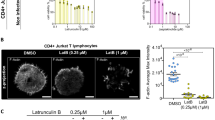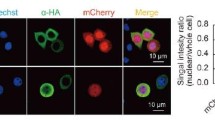Abstract
We previously found that infection with human parainfluenza virus type 2 (hPIV-2), a member of the genus Orthorubulavirus, family Paramyxoviridae, causes filamentous actin (F-actin) formation to promote viral growth. In the present study, we investigated whether similar regulation of F-actin formation is observed in infections with other rubulaviruses, such as parainfluenza virus type 5 (PIV-5) and simian virus 41 (SV41). Infection with these viruses caused F-actin formation and RhoA activation, which promoted viral growth. These results indicate that RhoA-induced F-actin formation is important for efficient growth of these rubulaviruses. Only SV41 and hPIV-2 V and P proteins bound to Graf1, while the V and P proteins of PIV-5, mumps virus, and hPIV-4 did not bind to Graf1. In contrast, the V proteins of these rubulaviruses bound to both inactive RhoA and profilin 2. These results suggest that there are common and unique mechanisms involved in regulation of F-actin formation by members of the genus Orthorubulavirus.






Similar content being viewed by others
References
Lamb RA, Parks GD (2013) Paramyxoviridae: the viruses and their replication. In: Knipe DM, Howley PM, Cohen JI, Griffin DE, Lamb RA, Martin MA, Racaniello VR, Roizman B (eds) Fields virology, vol 1, 6th edn. Lippincott Williams & Wilkins, Philadelphia, pp 975–995
Ohgimoto S, Bando H, Kawano M, Okamoto K, Kondo K, Tsurudome M, Nishio M, Ito Y (1990) Sequence analysis of P gene of human parainfluenza type 2 virus: P and cysteine-rich proteins are translated by two mRNAs that differ by two nontemplated G residues. Virology 177:116–123
Ohta K, Matsumoto Y, Yumine N, Nishio M (2018) The V protein of human parainfluenza virus type 2 promotes RhoA-induced filamentous actin formation. Virology 524:90–96. https://doi.org/10.1016/j.virol.2018.08.015
Witke W (2004) The role of profilin complexes in cell motility and other cellular processes. Trends Cell Biol 14:461–469. https://doi.org/10.1016/j.tcb.2004.07.003
Goldschmidt-Clermont PJ, Furman MI, Wachsstock D, Safer D, Nachmias VT, Pollard TD (1992) The control of actin nucleotide exchange by thymosin beta 4 and profilin. A potential regulatory mechanism for actin polymerization in cells. Mol Biol Cell 3:1015–1024. https://doi.org/10.1091/mbc.3.9.1015
Watanabe N, Madaule P, Reid T, Ishizaki T, Watanabe G, Kakizuka A, Saito Y, Nakao K, Jockusch BM, Narumiya S (1997) p140mDia, a mammalian homolog of Drosophila diaphanous, is a target protein for Rho small GTPase and is a ligand for profilin. EMBO J 16:3044–3056. https://doi.org/10.1093/emboj/16.11.3044
Watanabe N, Kato T, Fujita A, Ishizaki T, Narumiya S (1999) Cooperation between mDia1 and ROCK in Rho-induced actin reorganization. Nat Cell Biol 1:136–143. https://doi.org/10.1038/11056
Bos JL, Rehmann H, Wittinghofer A (2007) GEFs and GAPs: critical elements in the control of small G proteins. Cell 129:865–877. https://doi.org/10.1016/j.cell.2007.05.018
Ohta K, Goto H, Matsumoto Y, Yumine N, Tsurudome M, Nishio M (2016) Graf1 controls the growth of human parainfluenza virus type 2 through inactivation of RhoA signaling. J Virol 90:9394–9405. https://doi.org/10.1128/JVI.01471-16
Ohta K, Matsumoto Y, Nishio M (2019) Profilin 2 is required for filamentous actin formation induced by human parainfluenza virus type 2. Virology 533:108–114. https://doi.org/10.1016/j.virol.2019.05.013
Nishio M, Tsurudome M, Ito M, Watanabe N, Kawano M, Komada H, Ito Y (1997) Human parainfluenza virus type 2 phosphoprotein: mapping of monoclonal antibody epitopes and location of the multimerization domain. J Gen Virol 78:1303–1308. https://doi.org/10.1099/0022-1317-78-6-1303
Tsurudome M, Nishio M, Komada H, Bando H, Ito Y (1989) Extensive antigenic diversity among human parainfluenza type 2 virus isolates and immunological relationships among paramyxoviruses revealed by monoclonal antibodies. Virology 171:38–48
Szaszi K, Paulsen A, Szabo EZ, Numata M, Grinstein S, Orlowski J (2002) Clathrin-mediated endocytosis and recycling of the neuron-specific Na+/H+ exchanger NHE5 isoform. Regulation by phosphatidylinositol 3’-kinase and the actin cytoskeleton. J Biol Chem 277:42623–42632. https://doi.org/10.1074/jbc.M206629200
Shahriari S, Wei KJ, Ghildyal R (2018) Respiratory syncytial virus matrix (M) protein interacts with actin in vitro and in cell culture. Viruses 10:E535. https://doi.org/10.3390/v10100535.14
Hildebrand JD, Taylor JM, Parsons JT (1996) An SH3domain-containing GTPase-activating protein for Rho and Cdc42 associates with focal adhesion kinase. Mol Cell Biol 16:3169–3178
Taylor JM, Macklem MM, Parsons JT (1999) Cytoskeletal changes induced by GRAF, the GTPase regulator associated with focal adhesion kinase, are mediated by Rho. J Cell Sci 112:231–242
Shibata H, Oishi K, Yamagiwa A, Matsumoto M, Mukai H, Ono Y (2001) PKNβ interacts with the SH3 domains of Graf and a novel Graf related protein, Graf2, which are GTPase activating proteins for Rho family. J Biochem 130:23–31
Doherty GJ, Åhlund MK, Howes MT, Morén B, Partonc RG, McMahon HT, Lundmark R (2011) The endocytic protein GRAF1 is directed to cell-matrix adhesion sites and regulates cell spreading. Mol Biol Cell 22:4380–4389. https://doi.org/10.1091/mbc.E10-12-0936
Nishio M, Tsurudome M, Ito M, Garcin D, Kolakofsky D, Ito Y (2005) Identification of paramyxovirus V protein residues essential for STAT protein degradation and promotion of virus replication. J Virol 79:8591–8601. https://doi.org/10.1128/JVI.79.13.8591-8601.2005
Ohta K, Matsumoto Y, Ito M, Nishio M (2017) Tetherin antagonism by V proteins is a common trait among the genus Rubulavirus. Med Microbiol Immunol 206:319–326. https://doi.org/10.1007/s00430-017-0509-y
Kitagawa Y, Yamaguchi M, Zhou M, Nishio M, Itoh M, Gotoh B (2013) Human parainfluenza virus type 2 V protein inhibits TRAF6-mediated ubiquitination of IRF7 to prevent TLR7- and TLR9-dependent interferon induction. J Virol 87:7966–7976. https://doi.org/10.1128/JVI.03525-12
Ogawa M, Mutsuga N, Tsurudome M, Kawano M, Matsumura H, Kusagawa S, Komada H, Nishio M, Ito Y (1992) Nucleotide sequence analysis of the simian virus 41 gene encoding the large (L) protein and construction of a phylogenetic tree for the L proteins of paramyxoviruses. J Gen Virol 73:2743–2750. https://doi.org/10.1099/0022-1317-73-10-2743
Kawano M, Tsurudome M, Oki N, Nishio M, Komada H, Matsumura H, Kusagawa S, Ohta H, Ito Y (1993) Sequence determination of the P gene of simian virus 41: presence of irregular deletions near the RNA-editing sites of paramyxoviruses. J Gen Virol 74:911–916. https://doi.org/10.1099/0022-1317-74-5-911
Acknowledgements
We acknowledge proofreading and editing by Benjamin Phillis, and statistical support by Dr. Toshio Shimokawa at the Clinical Study Support Center, Wakayama Medical University.
Funding
This work was supported by a Grant-in-Aid for Scientific Research from the Ministry of Education, Culture, Sports, Science and Technology, Japan (JP17K15703). This work was also supported by GSK Japan Research Grant 2018.
Author information
Authors and Affiliations
Corresponding author
Ethics declarations
Conflict of interest
The authors declare no conflicts of interest.
Additional information
Handling Editor: Bert K. Rima.
Publisher's Note
Springer Nature remains neutral with regard to jurisdictional claims in published maps and institutional affiliations.
Rights and permissions
About this article
Cite this article
Ohta, K., Matsumoto, Y. & Nishio, M. Common and unique mechanisms of filamentous actin formation by viruses of the genus Orthorubulavirus. Arch Virol 165, 799–807 (2020). https://doi.org/10.1007/s00705-020-04565-y
Received:
Accepted:
Published:
Issue Date:
DOI: https://doi.org/10.1007/s00705-020-04565-y




